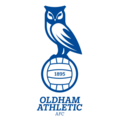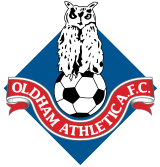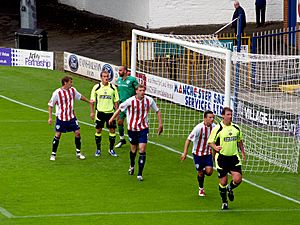Oldham Athletic A.F.C. facts for kids
 |
||||
| Full name | Oldham Athletic Association Football Club | |||
|---|---|---|---|---|
| Nickname(s) | Latics, The Blues, The Owls | |||
| Founded | July 1895 (as Pine Villa F.C.) | |||
| Ground | Boundary Park | |||
| Capacity | 13,560 | |||
| Chairman | Frank Rothwell | |||
| Manager | Micky Mellon | |||
| League | League Two | |||
| 2018–19 | League Two, 14th of 24 | |||
|
||||
Oldham Athletic Association Football Club is a professional association football team from Oldham, Greater Manchester, England. They are often called the "Latics" by their fans. As of the 2025–26 season, they play in EFL League Two, which is the fourth level of English football.
The club started as Pine Villa F.C. in 1895. They played in local leagues. In 1899, another local team, Oldham County, stopped playing. Pine Villa then moved to Boundary Park and changed their name to Oldham Athletic A.F.C. They quickly became successful, winning the Lancashire Combination league in 1906–07. This helped them join the Football League.
Oldham Athletic moved up to the top division in 1909–10. They nearly won the league in 1914–15, finishing second. After some ups and downs, they were relegated in 1923 and again in 1935. They won the Third Division North in 1952–53 but went down again the next season.
Later, under manager Joe Royle, Oldham had a very successful period. They reached the League Cup final in 1990. In 1990–91, they won the Second Division title. This meant they played in the top league for the first time in 68 years. They were also one of the founding teams of the new Premier League in 1992.
After being relegated from the Premier League in 1994, the club faced many challenges. In 2022, they were relegated from EFL League Two to the National League. This made them the first former Premier League club to play outside the main Football League. However, they returned to the Football League in 2025 after winning the 2025 National League play-off final.
Oldham Athletic plays its home games at Boundary Park. The team traditionally wears blue shirts. They have rivalries with other local teams like Rochdale, Bolton Wanderers, and Huddersfield Town.
Club History
How it All Began
In July 1895, a man named John Garland and his son started a football club called Pine Villa Football Club. They named it after a local mill. The "Villa" part came from Aston Villa, a very strong team at that time.
In 1899, a nearby team called Oldham County stopped playing. Pine Villa then changed its name to Oldham Athletic Football Club. They also moved into Oldham County's stadium, Boundary Park. The club quickly became professional and joined the Lancashire Combination and Lancashire League. By 1907–08, Oldham Athletic was accepted into the Football League. After three years in the Second Division, the Latics moved up to the First Division.
Oldham became a strong team, finishing 4th in the league in 1912–13. They also reached the F.A. Cup semi-finals that same season. In 1914–15, they almost won the league, missing out by just one point. This was the closest they have ever come to winning the top league title. The First World War then stopped their early success.
Challenges Between the Wars
After the First World War, Oldham Athletic found it hard to get back to their winning ways. They were relegated to the Second Division in 1923. It would be 68 years before they played in the top division again. Many players from their earlier successful teams had either retired or died in the war.
Their best result during this time was finishing 3rd in the 1929–30 season. They missed promotion by just two points behind Chelsea. After this, they slowly dropped down the league table. In 1934–35, they were relegated to the Third Division North. They did better in this new division, finishing in the top five for three seasons. Promotion seemed possible, but the Second World War started in 1939, stopping league football.
After the Second World War
After the war, Oldham Athletic did not find immediate success. The club struggled until George Hardwick became player-manager in November 1950. Hardwick was a famous player who had captained England. The club paid a large amount of money for him, which excited the fans.
In Hardwick's first full season, Oldham finished 4th. Home crowds were large, with 33,450 fans watching a game against Stockport County in March 1952. In one game, they set a club scoring record by beating Chester 11–2. Eric Gemmell scored seven goals in that match, which is still a club record. The next season, Oldham Athletic won their division and were promoted to the Second Division.
However, with older players and little money for new ones, the next season was tough. They won only eight games and were quickly relegated back to the Third Division North. Hardwick resigned in 1955. The club continued to struggle, even finishing in 23rd place in 1959–60. This was their lowest ever position in the Football League.
In the early 1960s, Ken Bates became chairman and Jack Rowley became manager. The club's luck changed. In 1962–63, Oldham Athletic was promoted to the Third Division. Over the next few years, the club had many different managers and struggled to be consistent. In 1968–69, they were relegated again. Jimmy Frizzell became manager in 1969, and he stayed for 13 seasons.
The Frizzell and Royle Years
In the 1970–71 season, Oldham finished third and were promoted back to the Third Division. In 1973–74, the Latics finished 1st and returned to the Second Division for the first time in 21 years. They stayed in the Second Division for the rest of Frizzell's time as manager.
In June 1982, Joe Royle became the manager. Royle's team nearly won promotion to the top division in 1986–87. In 1990, Royle's Latics reached Wembley Stadium for the Littlewoods Cup Final, but they lost 1–0 to Nottingham Forest.
The next season, Oldham won the Second Division. This meant they were back in the top division for the first time in 68 years. In their first season back, the club finished 17th and became founding members of the new Premier League. After two more seasons in the top league, Oldham was relegated again. In 1994, Joe Royle left the club to manage Everton.
During this time, Oldham Athletic reached the FA Cup semi-finals twice. Both times they lost to Manchester United. In 1994, they were very close to winning at Wembley, but Manchester United scored a late goal. Many Oldham fans believe this moment marked the start of a difficult period for the club. Oldham was relegated on the final day of that season.
Challenges in the Second and Third Tiers (1994–2018)
After Joe Royle left, Graeme Sharp became player-manager. However, Oldham was relegated to Division Two at the end of the 1996–97 season. They stayed in the third tier for 21 years. Many managers came and went, but the club struggled to get promoted.
In 2001, businessman Chris Moore bought Oldham Athletic. He promised to get the club back to the Premier League. The team played better under manager Iain Dowie and almost won promotion in 2003. However, Moore then decided to sell the club, leaving it with large debts. For a while, it looked like the club might close down, but a new group of owners took over.
In 2004–05, Simon Blitz, Simon Corney, and Danny Gazal bought Oldham Athletic. They worked to pay off debts, and the club struggled for several seasons. In 2006–07, Oldham nearly won promotion again but lost in the play-offs. Managers continued to change frequently.
In January 2015, the club considered signing a player. This caused a lot of public debate and strong reactions, including protests from fans and sponsors. Due to this "unbearable pressure" and threats, the club decided not to sign the player.
In January 2018, Moroccan football agent Abdallah Lemsagam bought most of the club. Before this, Oldham had faced problems with unpaid taxes.
Recent Years: Relegation and Return (2018–Present)
Oldham was relegated to EFL League Two on 5 May 2018. This was the first time they had been in the fourth tier since 1971. The club continued to face financial problems.
In August 2020, former Australia international Harry Kewell became manager. He was later sacked in March 2021. Keith Curle took over, but his efforts were made difficult by a transfer ban and fan protests against the owner.
In December 2021, owner Lemsagam announced he was willing to sell the club. John Sheridan was re-appointed as manager in January 2022. However, he could not stop the team from being relegated to the National League. On 23 April 2022, Oldham became the first former Premier League team to drop out of the Football League. This match was stopped by fans protesting against the club's owner.
After relegation, fans campaigned for a community takeover. On 28 July 2022, businessman Frank Rothwell bought the club. Oldham also worked to buy back Boundary Park from its former owner, a deal completed in March 2023.
Oldham started their first National League season with a new manager, David Unsworth. They finished 12th. Unsworth was replaced by Micky Mellon in September 2023. Oldham Athletic returned to the Football League in 2025 after winning the National League play-off final against Southend United.
Team Kit and Badge
Oldham Athletic first played in red and white striped shirts with blue shorts. Later, the red stripes became blue, then the shirt became white with a blue stripe. In the mid-1960s, the kit changed to orange shirts with blue shorts. Since the mid-1970s, the club has mostly worn all blue shirts.
A new club badge was introduced in 2011–12. It uses the traditional blue and white colours. It still has an image of an owl, which is a symbol for the club.
Kit Suppliers and Shirt Sponsors
Here is a table showing the companies that made Oldham's kits and sponsored their shirts over the years:
| Period | Kit manufacturer | Shirt sponsor (chest) |
|---|---|---|
| 1975–79 | Umbro | none |
| 1979–81 | Redsure | |
| 1981–82 | none | |
| 1982–83 | J.W. Lees Brewery | |
| 1983–85 | Le Coq Sportif | |
| 1985–87 | Spall | |
| 1987–88 | Umbro | |
| 1988–89 | Martins | |
| 1989–92 | Bovis | |
| 1992–96 | JD Sports | |
| 1996–98 | Pony | |
| 1998–2000 | Slumberland | |
| 2000–01 | Sparta | |
| 2001–03 | Torex | |
| 2003–04 | Horners | |
| 2004–05 | Carlotti | |
| 2005–06 | Carlotti | |
| 2006–08 | Hillstone Developments | |
| 2008–12 | Carbrini | Carbrini |
| 2012–13 | Fila | |
| 2013–14 | Blacks Outdoor Retail | |
| 2014–15 | Sondico | Sports Direct |
| 2015–18 | PFE Express | |
| 2018–19 | Lovell Soccer | |
| 2019–20 | Hummel | Wakelet |
| 2020–21 | Oldham Vending Services | |
| 2021–23 | Bartercard | |
| 2023–25 | Puma | RRG Group |
Stadium: Boundary Park
Oldham Athletic plays its home games at Boundary Park. The stadium was first used by Oldham's original football club, Oldham County F.C. When Pine Villa moved in, they renamed both the club and the stadium. Boundary Park can hold 13,560 fans.
The record number of fans at Boundary Park was 47,671. This happened during an FA Cup game between Oldham and Sheffield Wednesday in 1930.
In 2006, the club planned to rebuild the stadium. These plans were put on hold due to economic problems. Later, in 2009, the club and Oldham Council looked at building a completely new stadium in Failsworth. However, they eventually decided to redevelop Boundary Park instead.
Work began on a new North Stand at Boundary Park in May 2013. This new stand, now called the Joe Royle Stand, opened in stages in 2015. It has seats for 2,671 spectators and includes new facilities like a gym, club shop, and event centre.
Famous Fans
Many well-known people support Oldham Athletic. These include the comedy duo Cannon and Ball, who even rewrote a song for the club. Professor and former musician Brian Cox is also a fan. Other famous supporters include ex-Manchester United footballer Paul Scholes, rugby captain Kevin Sinfield, musician Danny Moores from The Courteeners, model Michelle Marsh, actor Alex Carter, and comedian Eric Sykes.
Rivalries
Oldham Athletic has several local rivals. Their stadium, Boundary Park, is close to many other football grounds in the area.
Traditional rivals include Bolton Wanderers, Bury, Huddersfield Town, Rochdale, and Stockport County. A survey in 2019 showed that Latics fans see Rochdale as their main rival, followed by Bolton Wanderers and Huddersfield Town.
Oldham Athletic also has a long-standing friendship with fans of German club Eintracht Frankfurt. Some Frankfurt supporters often travel to watch Oldham Athletic games.
Players
First-team Squad
|
|
Youth Team
Oldham Athletic also has a youth team, helping young players develop their skills.
|
|
Women's Team
Oldham Athletic has a women's team that plays in the Greater Manchester Women's Football League. In February 2024, the club announced a women's academy program. This program helps female players train full-time and get a full-time education.
Club Management
Club Officials
| Staff | |
|---|---|
| Chairman | Frank Rothwell |
| Directors | Frank Rothwell, Luke Rothwell, Su Schofield, Darren Royle, Joe Royle, Kevin Roberts |
| CEO | Darren Royle |
| Club Secretary | Mark Sheridan |
| Chief Finance Officer | Donna Worthington |
| Finance Executive | Laura Ribchester |
| Football Liaison Officer | Sue Bowskill |
| Safety Officer | Rod Cross |
| Club Doctors | Dr David Nichols & Dr Natalie Cheyne |
| Crowd Doctor | Dr Jim Weems |
Coaching Positions
| Staff | |
|---|---|
| Manager | Micky Mellon |
| Assistant manager | Gary Brabin |
| Goalkeeper coach | Scott Davies |
| Physiotherapists | Ian Liversedge, Luke Livsey, Claire Swindall |
| Head of Performance | Andrew Hodgen |
| Sports Scientist, Strength & Conditioning Coach | Trystan Jones |
| Performance Analyst | Jason Scrivener |
Academy Staff
| Staff | |
|---|---|
| Academy manager | Phil Arbelo-Dolan |
| Head of coaching | Nicky Adams, Danny Philliskirk |
| Assistant academy coaches | Ryan Williams, Trey Turner |
| Physiotherapist | Paris Kay |
Managerial History
Only three managers have won a league title for Oldham Athletic: George Hardwick (1953), Jimmy Frizzell (1974), and Joe Royle (1991).
David Ashworth was a very successful manager. He led the team to win the Lancashire Combination Championship in 1906. In 1910, he helped them get promoted to the top division of English football. Ashworth later managed Liverpool and led them to win the League Championship in 1921–22. He is the only Oldham Athletic manager to have won the Football League Championship with any club.
Club Achievements
Oldham Athletic has won several titles and achieved important milestones:
League Titles
- First Division (top league)
- Second place: 1914–15
- Second Division (level 2)
- Champions: 1990–91
- Second place: 1909–10
- Third Division North / Third Division (level 3)
- Champions: 1952–53, 1973–74
- Fourth Division (level 4)
- Second place: 1962–63
- Promoted: 1970–71
- National League (level 5)
- Play-off winners: 2025
- Lancashire Combination
- Champions: 1906–07
Cup Competitions
- Football League Cup
- Runners-up: 1989–90
- Lancashire Senior Cup
- Winners: 1908, 1967, 2006
- Anglo-Scottish Cup
- Runners–up: 1978–79
Club Records
Here are some of Oldham Athletic's impressive club records:
- Highest League finish: 2nd in Football League First Division, 1914–15
- Best FA Cup performance: Semi-finals, 1912–13, 1989–90, 1993–94
- Best League Cup performance: Final, 1989–90
- Record league victory: 11–0 vs. Southport, Division Four, Boundary Park, 26 December 1962
- Record FA Cup victory: 10–1 vs. Lytham, first round, Boundary Park, 28 November 1925
- Record League Cup victory: 7–0 vs. Scarborough, second round, Boundary Park, 25 October 1989
- Record league defeat: 13–4 vs. Tranmere Rovers, Division Three (North), Prenton Park, 26 December 1935
- Record FA Cup defeat: 6–0 vs. Huddersfield Town, third round, Leeds Road, 13 January 1932 and 6–0 vs. Tottenham Hotspur, third round, White Hart Lane, 14 January 1933
- Record League Cup defeat: 7–0 vs. Brentford, League Cup, third round, Brentford Community Stadium, 21 September 2021
- Record home attendance (all competitions): 47,671 vs. Sheffield Wednesday, FA Cup, fourth round, Boundary Park, 25 January 1930
- Record home league attendance: 45,304 vs. Blackpool, Division Two, Boundary Park 21 April 1930
- Longest unbeaten league run: 20 league games between 1 May 1990 and 17 November 1990 in Division Two
- Most league appearances: 525, Ian Wood, 1966–1980
- Most overall appearances (all competitions): 582, Ian Wood, 1966–1980
- Most league goals: 141, Roger Palmer, 1980–1994
- Most overall goals (all competitions): 156, Roger Palmer, 1980–1994
- Most league goals in a season: 33, Tom Davis, Division 3 (North), 1936–37
- Most overall goals in a season (all competitions): 38 Tom Davis, 1936–37
- Most goals by a single player in a league fixture: 7, Eric Gemmell, 26 December 1951, Division 3 (North)
- Most capped player: 25, Gunnar Halle – Norway, 1991–1996
- Record transfer fee paid: £750,000 Ian Olney, Aston Villa, June 1992
- Record transfer fee received: £1,700,000 Earl Barrett, Aston Villa, February 1992
- Oldest player: David Eyres aged 42, vs. Scunthorpe United, 6 May 2006
- Youngest player: Zak Emmerson, aged 15 years 73 days, vs. Walsall, 22 October 2019
See also
 In Spanish: Oldham Athletic Association Football Club para niños
In Spanish: Oldham Athletic Association Football Club para niños






